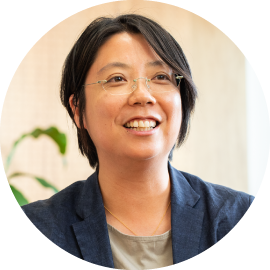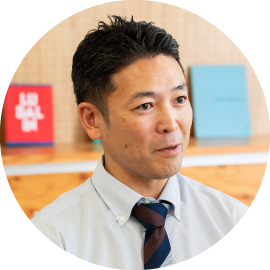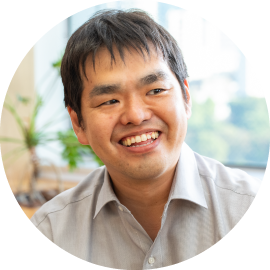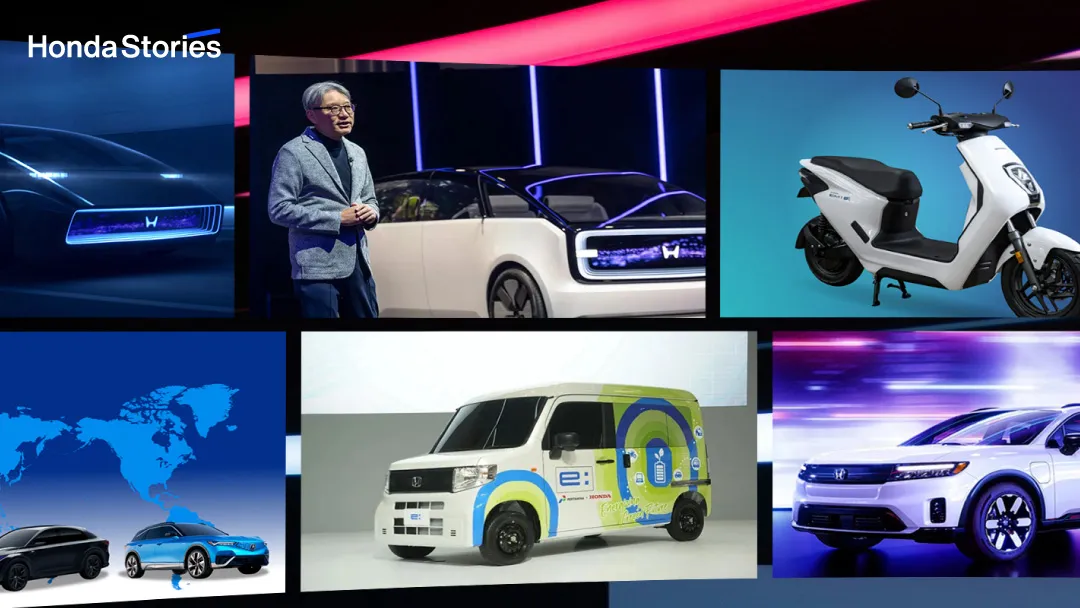The Energy System Design Development Unit, which is responsible for Honda’s electrification strategy, aims to promote the widespread adoption of BEVs*. What meaning is attributed to the term “Energy System Design”, and what vision drives their continued challenge towards the future? We asked five members, including Hirokazu Oguri, Head of the unit.
* An acronym for “Battery Electric Vehicle”, cars that run solely on electricity without the use of gasoline

Head of Energy System Design Development Unit
BEV Development Center
Electrification Business Development Operations
View More
Close
Kosuke Oguri
Read More

Chief Engineer
BEV Power Unit System Development Department
View More
Close
Chiho Itoga
Read More

Chief Engineer
eAxle System Development Department
View More
Close
Satoshi Honjo
Read More

Chief Engineer
Energy Service System Development Department
View More
Close
Shohei Taka
Read More

Chief Engineer
Energy Storage System Development Department
View More
Close
Ryo Fujii
Read More

Members of the Energy System Design Development Unit
From left to right: Shohei Taka (Energy System Development), Satoshi Honjo (eAxle Development), Kosuke Oguri (Head), Chiho Itoga (Performance Design), Ryo Fujii (Battery Pack Design)
There are hardly any associates at Honda who see electrification as a crisis
- First, could you tell us what kind of department the Energy System Design Development Unit is?
 Oguri says, “We’re not just making parts, but shaping society”
Oguri says, “We’re not just making parts, but shaping society”
- Honda aims to achieve a “global annual production of over 2 million EVs by 2030” and “100% EV and FCEV sales ratio globally by 2040”. How do those who are responsible for the backbone of this company-wide electrification strategy honestly feel about it?


What is important not to be misunderstood is that electrification is a means to an end. The goal is ultimately to reduce environmental impact and protect the Earth, so we are considering how society surrounding cars should be in order to achieve that.

Even in engine development, there were challenges related to environmental issues such as reducing exhaust emissions. Whether it’s engine vehicles or BEVs, I don’t think the purpose of reducing environmental impact differs much.

While the core idea of improving society through mobility remains the same, it is said that the automotive industry is undergoing a once-in-a-century period of transformation. I see these trends as opportunities as an engineer. Since entirely new things can be created with fresh ideas, rather than just thinking along the lines of previous technologies.

I agree. I think there are many people who are glad to have encountered this once-in-a-century opportunity. The desire to create something that will impact future life is a motivation for my work.
 Fujii, who is responsible for the design of large battery packs installed in BEVs
Fujii, who is responsible for the design of large battery packs installed in BEVs

It might be part of the company culture, but it seems that there are hardly any associates at Honda who see electrification as a crisis. Rather, I think there are many associates who are concerned about missing out on opportunities for personal growth by not engaging in electrification efforts.
“My” instead of Honda’s. Making it personal and passionately engaging in the work is the essence of Honda
- Could you please tell us what each of you is currently focusing on and the significance they feel within that?


The Energy Services I am involved in focuses on enhancing the convenience and efficiency of charging, devising strategies for utilizing BEVs as power sources, and collaborating with electric utility companies to stabilize the power network, rather than the development of BEVs themselves. I originally joined Honda with the intention of working on engines, but now I’m not even sure if my current job falls under the category of being a “car guy”. However, by positioning mobility as part of the infrastructure and designing the society’s system itself, I am deeply involved in meaningful endeavors.

Currently, I am primarily working on the design of large battery packs for BEVs. Since joining Honda, I have been involved in the field of batteries for a long time. However, compared to 10 years ago, societal trends and the value demanded of cars have completely changed, so there’s never a dull moment at work. Now, the focus is mainly on downsizing batteries and reducing charging time, but I also believe it’s necessary to delve deeper and conduct research on the nature of batteries and energy itself.

My main role is to stand between the proposal and development of the power unit system for BEVs, facilitating adjustments. It’s important to think about the future of cars with new ideas, and it’s also important to verify whether those ideas are feasible and what costs and resources they entail. Balancing and coordinating both aspects is challenging, but exchanging opinions with various people, both inside and outside the company, is enjoyable.
 Itoga serves as a “bridge” from conceptualizing products to development through performance alignment
Itoga serves as a “bridge” from conceptualizing products to development through performance alignment

I am working on the development of a component called “eAxle”, which integrates the power unit of BEVs, including the motor, inverter, gearbox, etc. I believe one of the major challenges facing BEVs is their high price. To address this, simply using inexpensive materials or increasing quantity to reduce costs may not be enough to keep up with the current situation. Therefore, we are continuously experimenting with new approaches to advance development. By the way, when asked to explain our development approach internally, I presented it under the title “My” eAxle. Oguri-san liked that presentation.
 Honjo, leading the development of “My” eAxle
Honjo, leading the development of “My” eAxle
- Even within a single department, there seems to be a wide range of tasks, and each person is able to demonstrate their individuality. How did Oguri-san feel about the presentation of “My” eAxle by Honjo-san?

The essence of Honda is to approach all tasks as personal matters and engage in them passionately. I made me glad to hear him say “My” in that sense. I thought it was a succinct expression of Honda’s essence. With a name like “Honda Motor Co., Ltd.” which literally translates to “Honda Technical Research Industry” in Japanese, rather than “Honda Automobile Industry”, it’s no surprise that Honda has many highly specialized associates, and the organization functions by respecting one another. I feel that it’s expected of those leading the team to understand the feelings of each associate, and to bring out their individuality and abilities in order to create value.
The first step in creating value is “serious daydreaming”
- Is collaboration with other companies necessary to explore various possibilities?

Carbon neutrality is a challenge not only for mobility companies but also for all industries related to energy. Therefore, it’s necessary to collaborate with various people and industries beyond existing frameworks, and I believe that promoting open innovation is a natural progression.

We also feel the collaboration with external partners at the grassroots level. For example, when creating charging stations for BEVs, we need to consider where and how to supply electricity, so it’s not simply a matter of replacing gasoline stations.
 Taka speaks of making mobility a part of the infrastructure through energy services
Taka speaks of making mobility a part of the infrastructure through energy services

It may be a bit of an exaggeration, but there is a demand to revisit urban planning, and it’s no longer something that automotive companies can handle on their own. In other words, there is a demand to redesign society as a whole, and I finally understand the meaning behind the department’s name, “Energy System Design Development Unit.”

Honda has a culture known as “Waigaya”, and as evident from the current discussion, there is an increasing demand for free discussions that are not confined by existing frameworks.
- The lively communication represented by “Waigaya” is indeed essential for innovation.

My experience working in the United States has had a significant impact on my awareness of the quality and quantity of dialogue. Working with staff who have different personalities and engineering perspectives requires dialogue above all else, and I learned in the United States that people are not just tools.

Oguri-san actively creates opportunities for panel discussions and meetings. He devotes energy and time to engage with team members by himself. As a subordinate, I am always grateful for that.

In addition to deliberate opportunities for dialogue, the culture of naturally fostering “Waigaya,” or lively discussions, is also a characteristic of Honda. When you have a problem and consult with someone, others who hear about it gather around and think about it as if it were their own issue.

The most enjoyable part of “Waigaya” is when you can’t tell the difference between discussion and casual conversation. You can freely express ideas and thoughts, and you often have surprising realizations as well.

Kind of like, “alright, let’s have a ‘Waigaya’ session today where we envision 2030”. Given that I enjoy science fiction, I find those imaginative battles quite enjoyable. It’s the best when the conversation gets lively because of something I said. The ultimate mobility, you ask? Well, that would have to be the “Anywhere Door”!

It’s common for us to seriously discuss such fantasies. Of course, we must converge the divergent ideas we’ve expressed and arrive at concrete answers. However, there’s absolutely no need to confine ourselves to the currently defined framework of cars. There’s also the possibility of using mobility in our living rooms, and I believe there will come a time when our grandchildren will ask, “Were there gas stations or charging stations back then?” We imagine various possibilities like this, form hypotheses, and then challenge them. That’s what the Energy System Design Development Unit is all about.
- The “Waigaya” of imagining the future of mobility never ends, does it? Finally, Oguri-san, please tell us about your personal dreams and goals.

As Honda’s slogan “The Power of Dreams” suggests, Honda values dreams, but recently I’ve come to realize that being “obsessed” is just as important as having dreams. People don’t feel much stress when they’re absorbed in something, and being obsessed can also bring out unexpected strength. Everyone in this department becomes passionate and absorbed in something. That’s the current dream, indeed.
 Serious daydreaming and dialogue create the future of mobility
Serious daydreaming and dialogue create the future of mobility
Original article issued on February 16, 2024
<Related Articles>










The main tasks include research and development of components used in Battery Electric Vehicles (BEVs) and peripheral facilities necessary for their proliferation. However, that understanding doesn’t just stop at mere manufacturing. How cars connect with society and how society should be in the future. I believe that we should be involved in research and development with a broad perspective. Actually, the provisional name for the department before its establishment was Electric Parts Development Unit, but we changed it to Energy System Design to reflect our determination.